LECTURE 3-STEM CELLS AND DIFFERENTIATION
1/37
There's no tags or description
Looks like no tags are added yet.
Name | Mastery | Learn | Test | Matching | Spaced |
|---|
No study sessions yet.
38 Terms
Key concepts from lecture 2- chapter 19
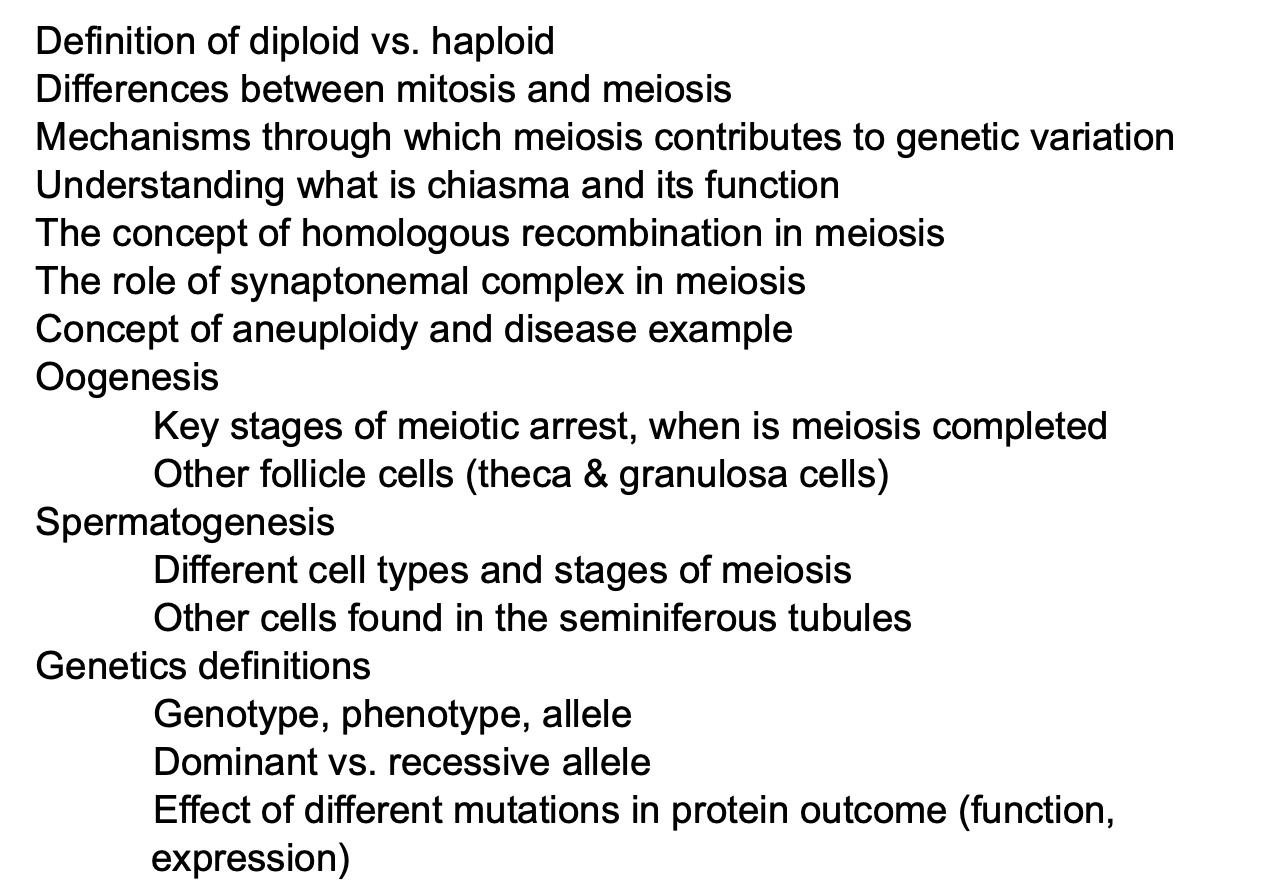
Three key questions from lecture 2 (chapter 19)
Do sperm have a centrosome? And do they only have one centriole?
the centrosome undergoes reduction of the pericentriolar material by loosing gamma tubulin ring complexes
spermatids have two centrioles but one centriole is remodeled and gives rise to the basal body that becomes part of the flagellum
What is the function of the acrosome?
contains proteolytic enzymes that when released help the entrance of the sperm into the egg
If meiosis is completed after fertilization but meiosis II gives rise to 4 haploid cells does that not affect the ploidy of the zygote?
asymmetric cell division leaves 1 cell that becomes the ovum which concentrates most of the cytoplasm
while the other daughter cells become polar bodies which in humans apoptose within 17 to 24 hours and the fragments become entrapped in the zona pellucida
OVERVIEW: stem cells and differentiation
1) definition of and different potencies of stem cells
2) embryonic versus adult/tissue-specific stem cell populations
3) Intestinal stem cells renew the gut epithelium
4) Stem cells and regenerative medicine
5) Introduction to primary literature and scientific journal articles
Totipotency vs. Differentiation
Totipotency: the ability of a single cell to direct the entire development of an organism i.e. zygote
Differentiation: the process by which a cell becomes specialized for a particular function i.e. erythrocyte
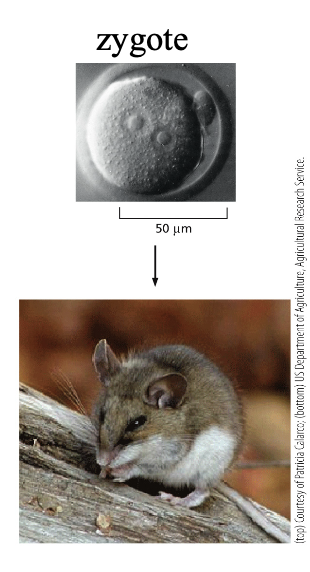
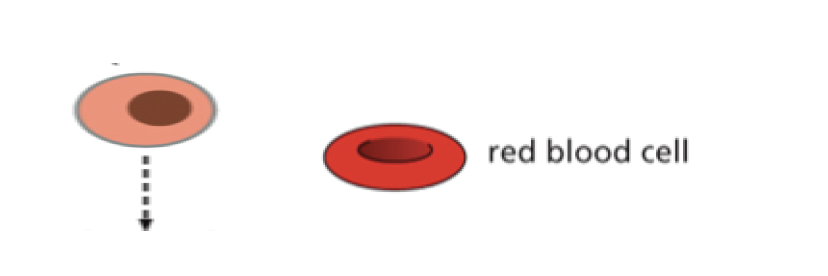
Stem cells can self renew and are precursors of differentiated cells
stem cells are undifferentiated self-renewing cells that produce daughter cells that can either differentiate or retain the stem cell potential of the parent cell
stem cells give rise to proliferating precursor cells. cell division before differentiation amplifies the number of differentiated cells that are produced
terminally differentiated cells are at the end of their developmental path

Stem cells can self renew and are precursors of differentiated cells
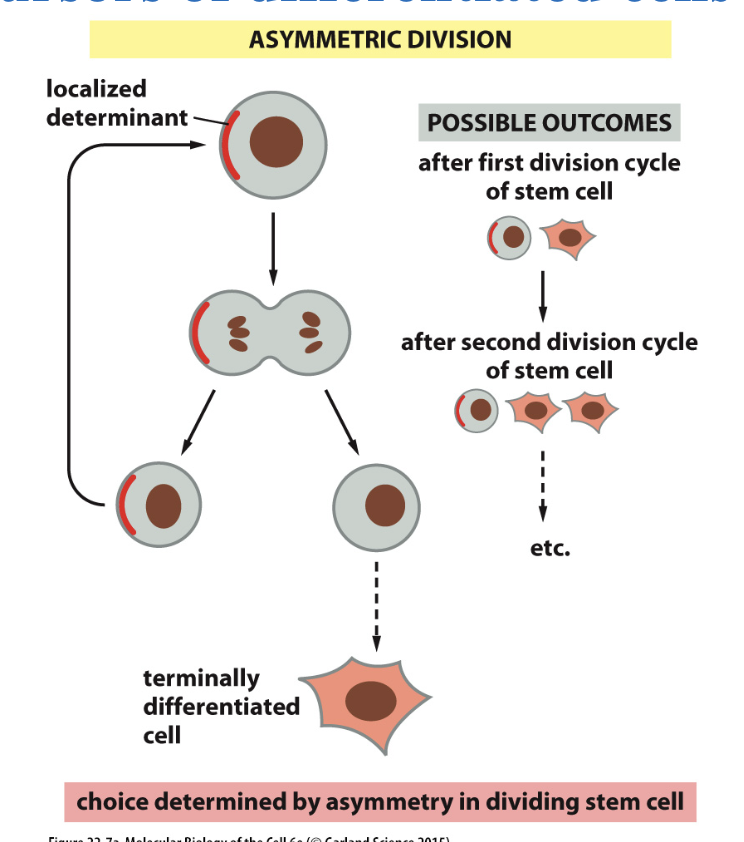
Stem cells can self renew and are precursors of differentiated cells
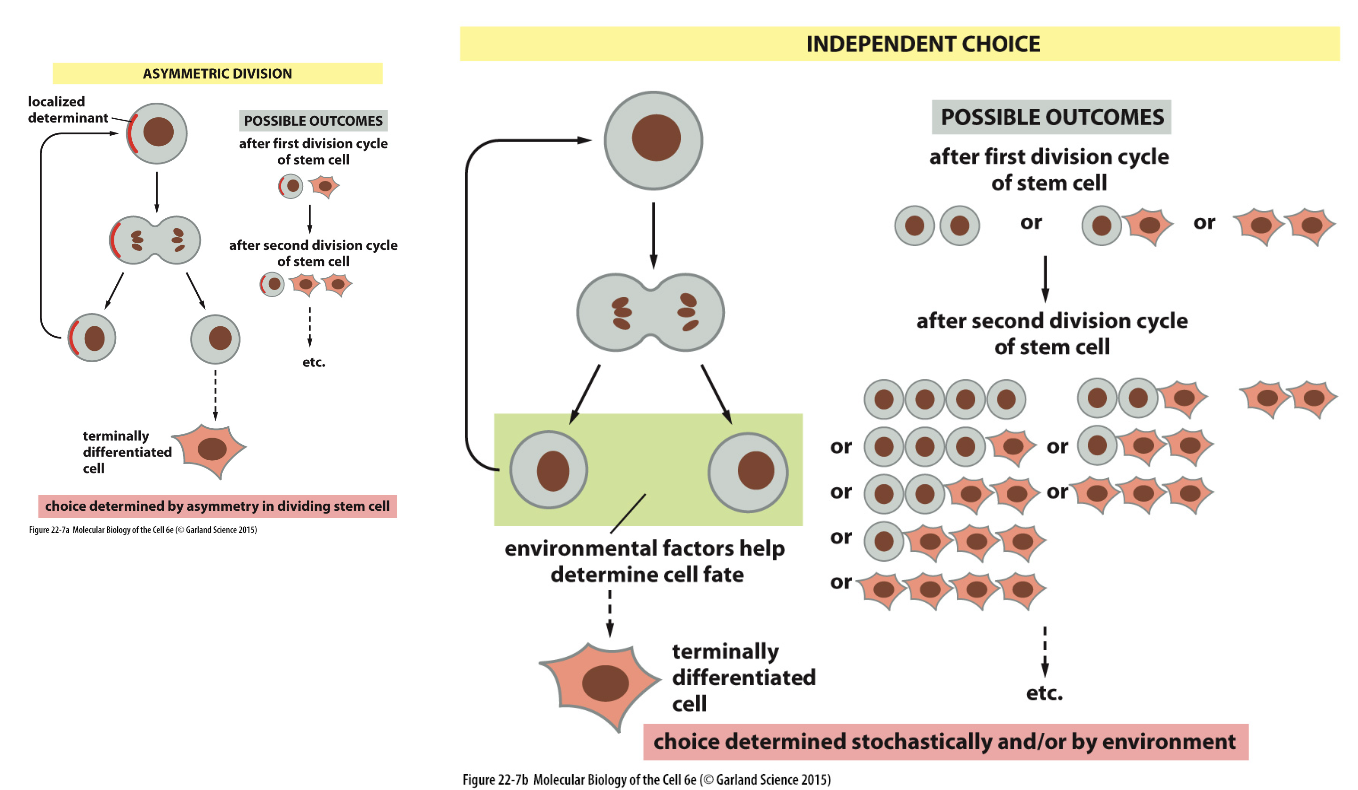
Embryonic vs. Adult stem cells
zygote is totipotent
Embryonic stem cells (ESCs) are derived from the inner cell mass and are pluripotent
Adult or tissue-specific stem cells are multipotent or unipotent

Stem Cell potential
Totipotent: a stem cell that is able to differentiate into all cell types, i.e. zygote
Pluripotent: a stem cell that is able to differentiate into many cell types i.e. embryonic stem cell (ESC)
Multipotent: a stem cell that can differentiate into a limited number of cell types. Most adult stem cells are multipotent i.e. hematopoietic stem cell (HSC)
Unipotent: a stem cell that can produce one cell type i.e. epidermal (skin) stem cell
Waddington’s Epigenetic Landscape (1957)
totipotent—>pluripotent—>multipotent—>unipotent—>differentiated

OH: just showing the order and how totipotent can lead to all cell types
Different tissues are renewed at different rates

Structure of the small intestine epithelial lining
fingerlike villi project into the intestinal lumen
the surface of each villus is a single-layered epithelium
the epithelium includes goblet cells that secrete mucus and brush-border cells that function in absorption
the epithelium also extends into the underlying connective tissue, forming crypts
the crypt is a stem cell niche which is a microenvironment required for continued stem cell renewal
OH: goblet cells secrete mucus and brush-border cells (just the name) absorb stuff from the lumen of gut
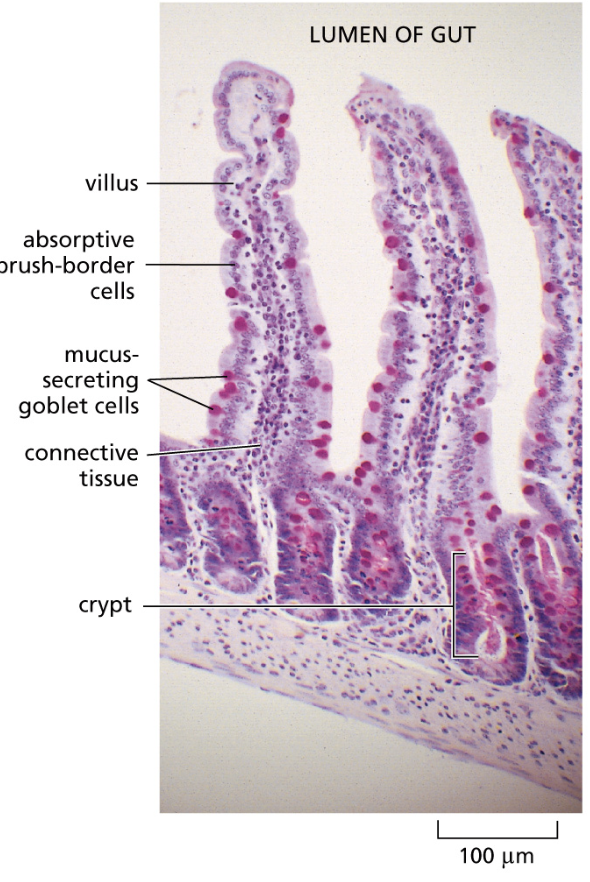
The small intestine lining is rapidly renewing
stem cells in the crypts divide and generate precursor cells that divide and differentiate into the specialized cells of the epithelium
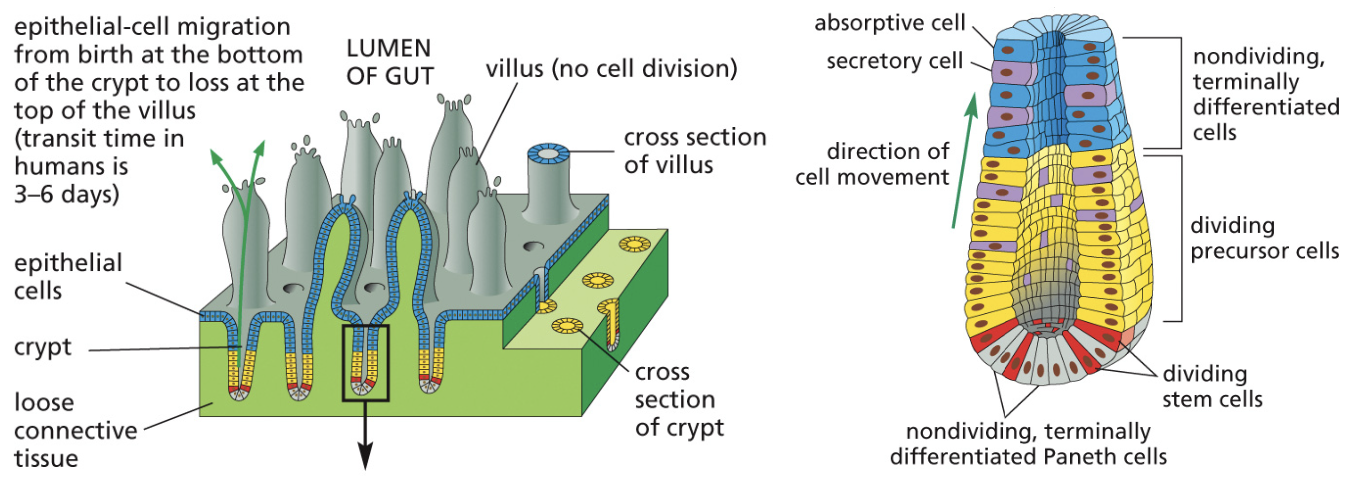
The small intestine lining is rapidly renewing
epithelial cells are continually traveling upward and are eventually lost at the top of the villus
stem cells also generate paneth cells (non-dividing) at the bottom of the crypts, which secrete antibacterial proteins and support stem cell renewal
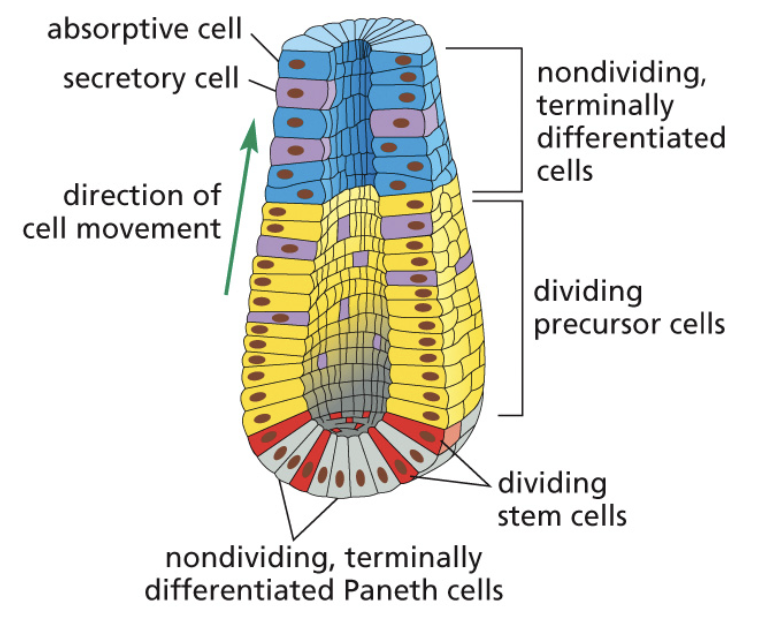
Molecular regulation of the intestinal crypt by WNT signaling
stem cells must be tightly regulated to ensure that new cells are generated at the right place and time
WNT signaling is active in the intestinal stem cell niche (crypt)
WNT signaling is inactive in the villi
WNT ligand (WNT3a) is produced in the paneth cells and promotes cell proliferation in the crypt

Visualization of WNT3 protein in the intestine
generation of a wnt3a knock in allele in the mouse
detection of wnt3 in the intestine by immunohistochemistry

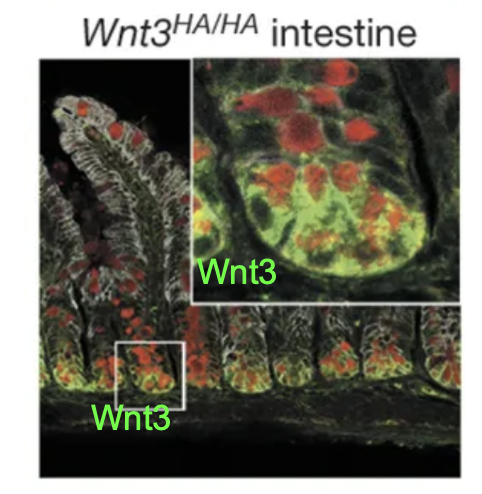
Wnt Signaling in the intestinal crypt
APC=adenomatous polyposis coli (not anaphase promoting complex)
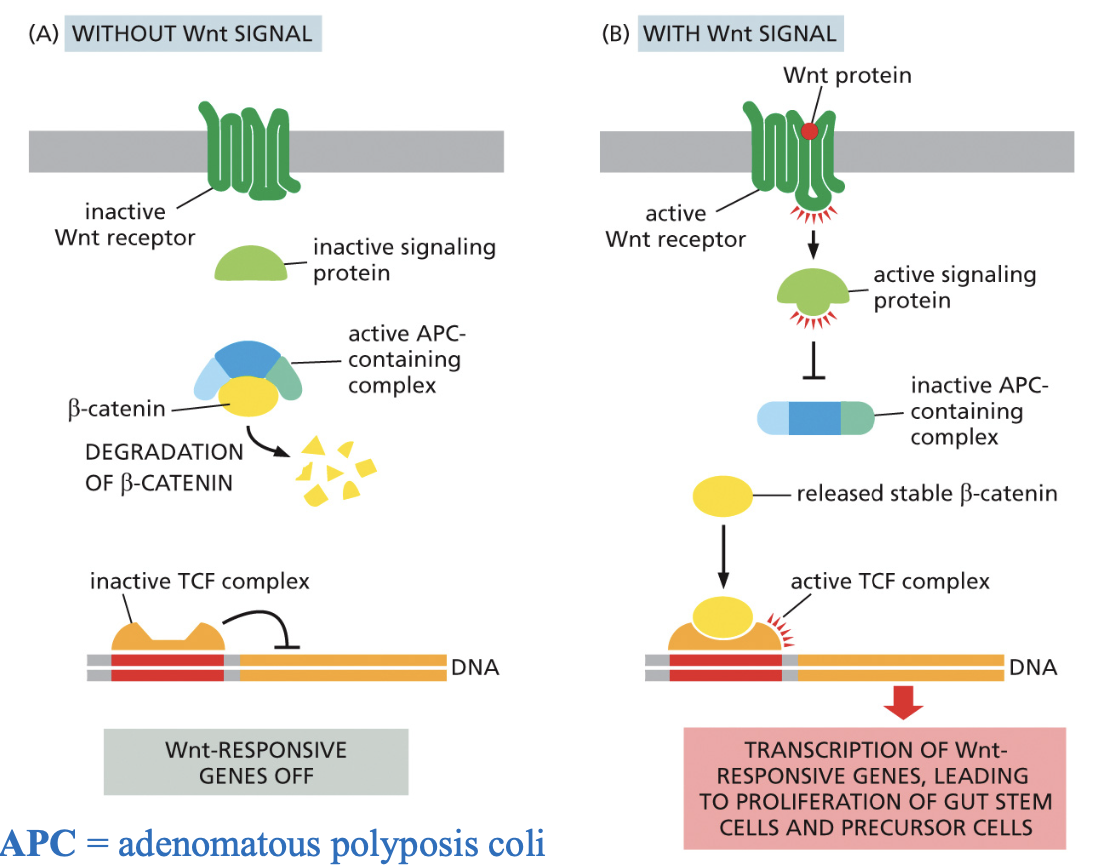
Dysregulated Wnt signaling disrupts intestinal morphology and function
increased WNT signaling by removing APC in the crypt for 2,3, or 4 days causes increased proliferation and expansion of the crypt compared to control animals
APC=adenomatous polyposis coli; mutations in APC cause human colon cancer

The epidermis is renewed by stem cells in the basal layer
the epidermis is a stratified epithelium
stem cells reside in the basal layer
epidermal stem cells are unipotent
WNT/b-Catenin signaling regulates epidermal stem cells
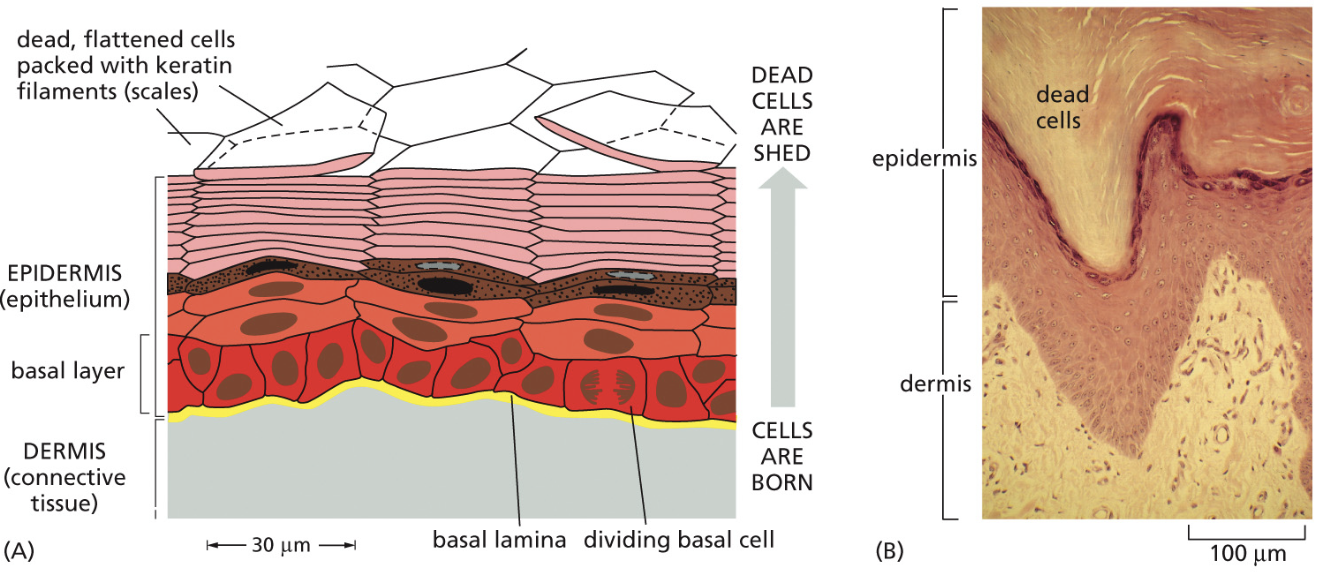
Hematopoietic stem cells generate all blood cell types
hematopoietic stem cells (HSCs) are multipotent
HSCs reside in the bone marrow and generate all blood cell types
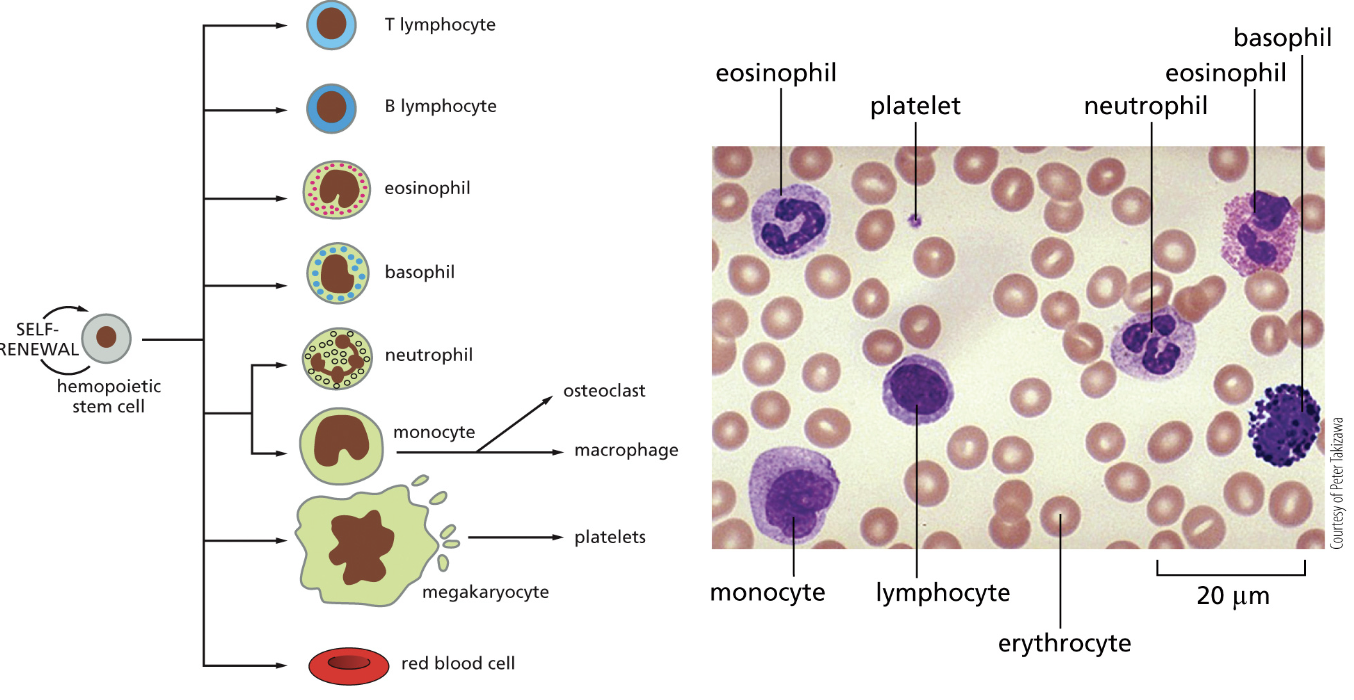
Close to 80% of Adult HSCs exist in a state of quiescence and can rapidly respond to a challenge
quiescent HSCs have exited the cell cycle
in response to acute inflammation adult HSCs undergo differentiation
stem cell niches in the bone marrow provides signals to reinforce quiescence of HSCs
WNT signaling maintains the HSCs stem cell niche
Stem cells don’t function alone, but are dependent on their microenvironment and signaling

Bone marrow transplantation depends on HSCs
bone marrow transplants are useful experimentally and clinically
transplants can be:
autologous: donor and recipient are the same individual
syngenic: recipient receives cells from a twin
allogenic: recipient receives cells from a (non-twin) family member or other individual
The patient’s stem cells are first destroyed by chemotherapy or radiation (usually because the patient has leukemia or lymphoma)
the grafted stem cells restore the functional bone marrow

Stem cells in the brain are multipotent
neurons: cells in the brain that receive, integrate and transmit signals. Formed through neurogenesis
Astrocytes: “star-like cells” with many functions including to remove excess signaling molecules, regulate synapse formation and maintenance
oligodendrocytes: glial cells that produce myelin to insulate neuronal axons and help neural signaling
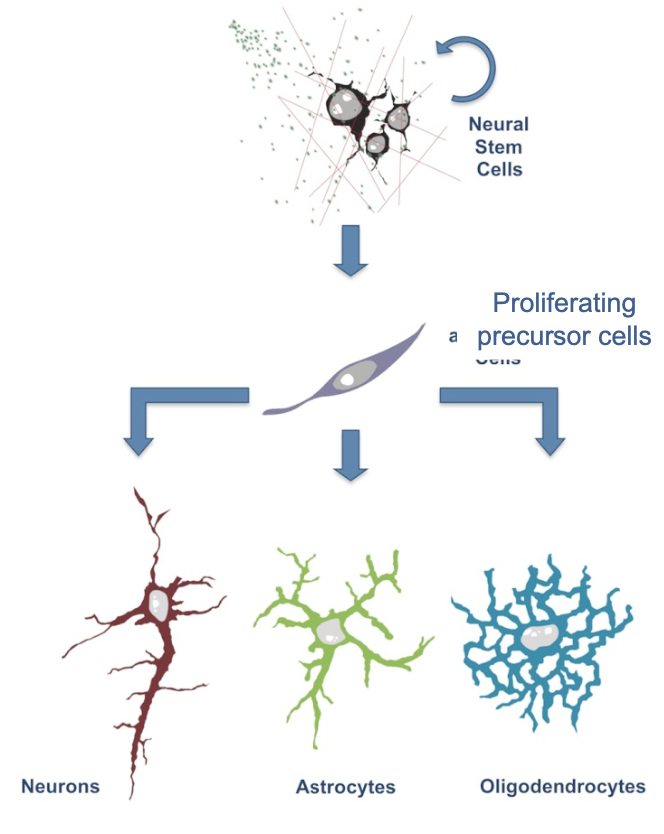
Stem cells in the adult brain
evidence for adult neurogenesis in mammals was challenged early on
neural stem cells (NSCs) reside in two regions of the adult brain, including the human brain: the subventricular zone (SVZ) and the dentate gyrus (part of the hippocampus)
NSCs in these regions give rise to neurons and other cell types in the brain
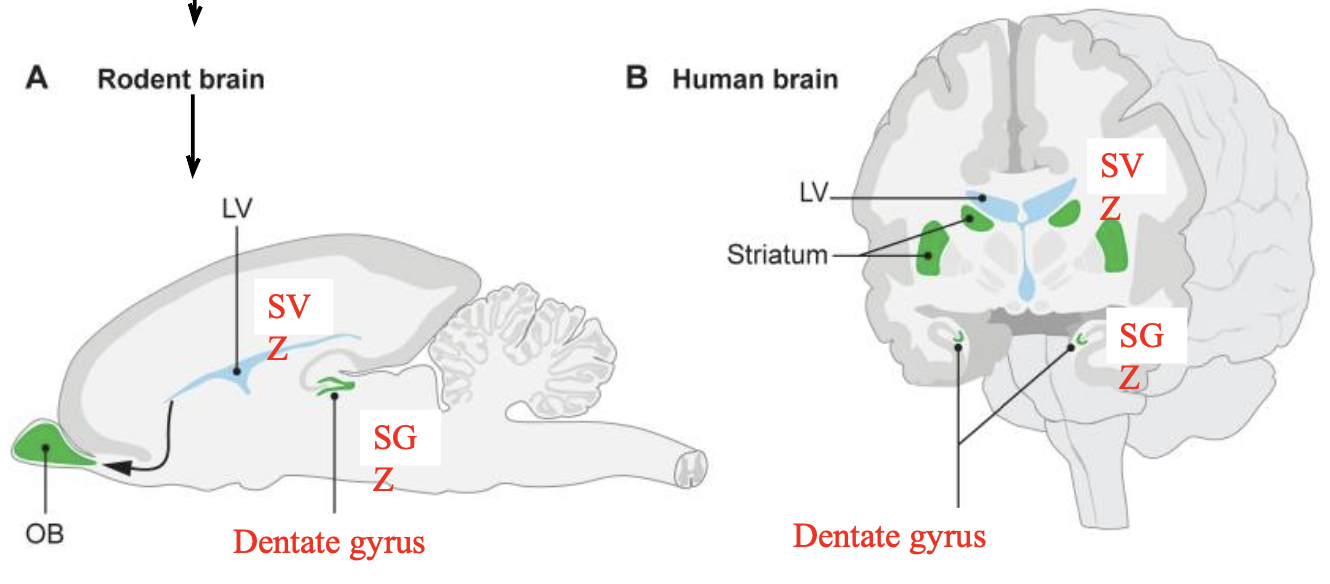
NSC niche in the SVZ
radial glia like cell is NSC
ependymal cells receive signals from the CSF (cerebro spinal fluid)
CSF contains growth factors, signaling molecules, proteins
NSC receives signals from ependymal cells, vasculature, and CSF
Neuroblasts generated in SVZ migrate to the olfactory bulb (OB) and differentiate into OB neurons-contribute to olfactory learning
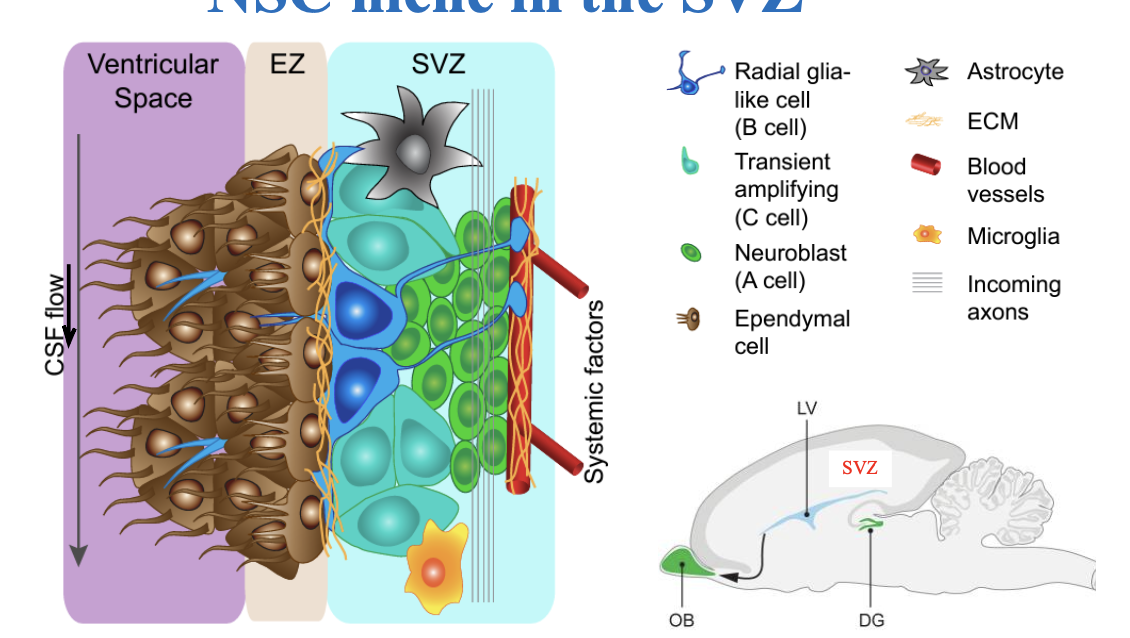
NSC niche in the SGZ
hippocampus important for learning and memory
NSC receive signals from vasculature and other cells
NSC generate transit amplifying cells (TAP)
TAPs make neuroblasts (postmitotic cell) that differentiates into neurons
new granule neurons proposed to be important for spatial learning and pattern discernment
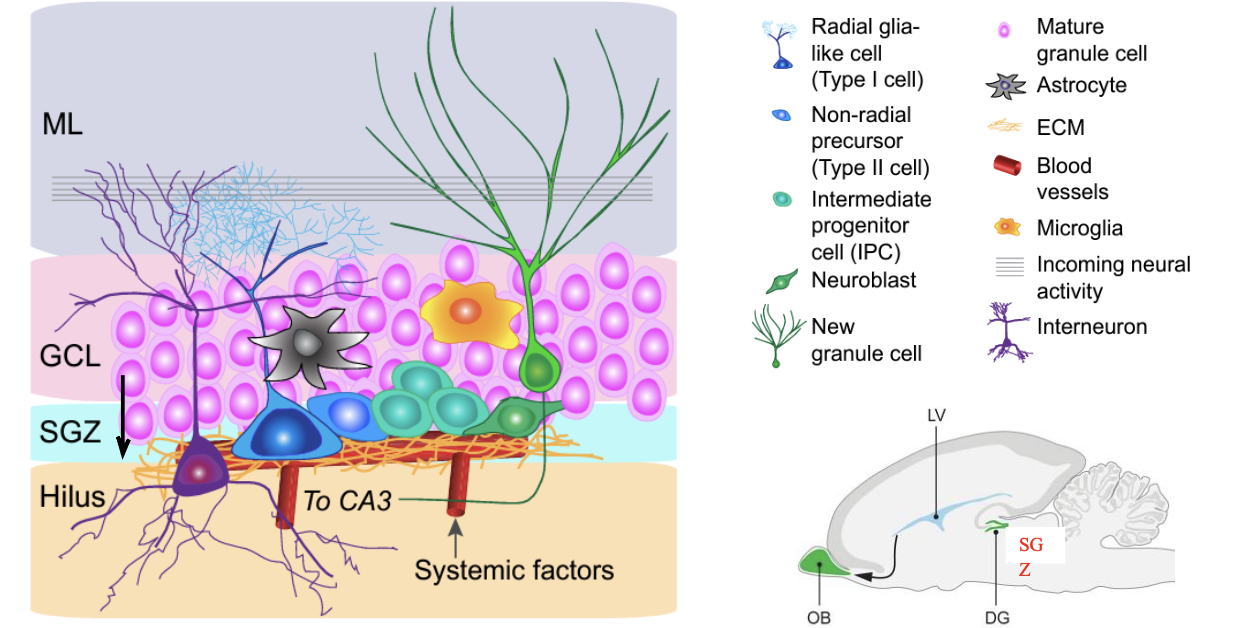
Somatic cell nuclear transfer in frogs (Gurdon, 1975)
somatic cell nuclear transfer=SCNT
nuclear reprogramming

It took a long time before the Gurdon experiments could be replicated in mammals
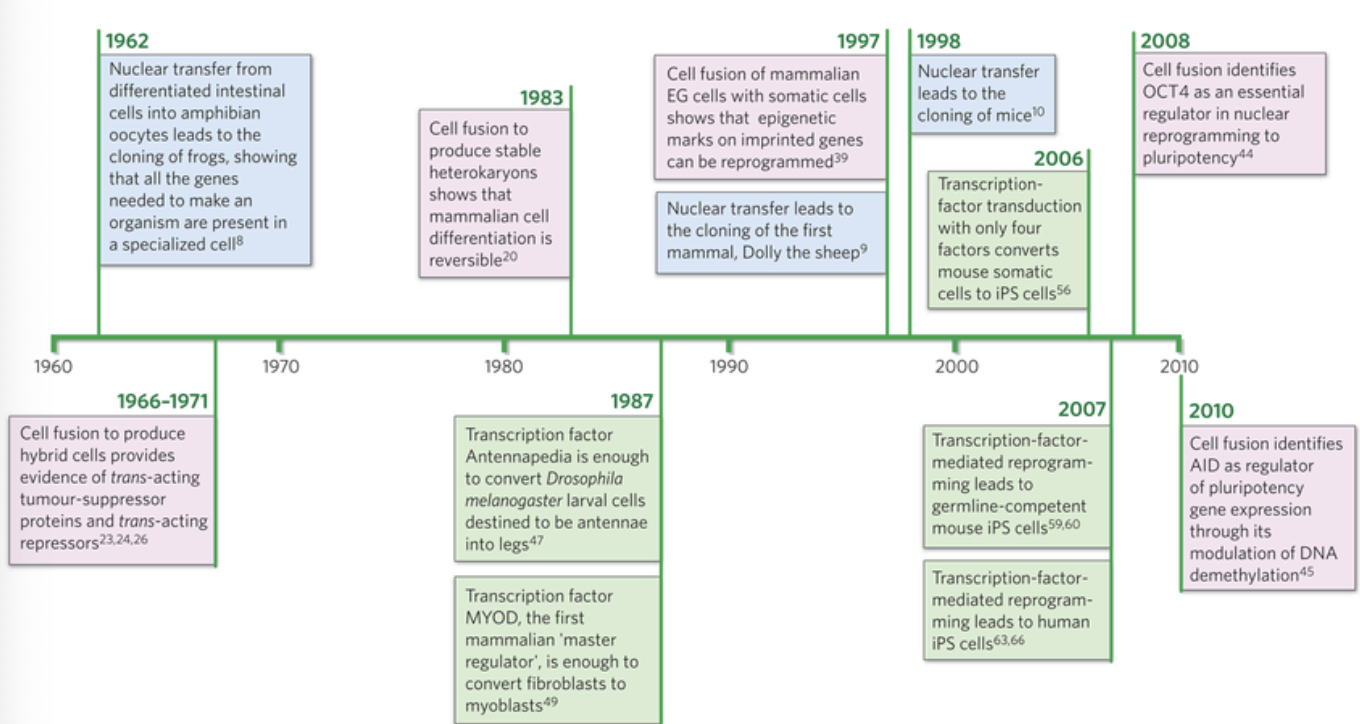
Mammalian somatic cell nuclei are totipotent
dolly is an example of reproductive cloning! Bonnie was born through normal conception meaning that cloning Dolly did not impair its reproductive capacity!
Fused nucleus of a mammary gland cell with an enucleated egg cell and gave the egg cell a electrical shock which triggered the start of cell division
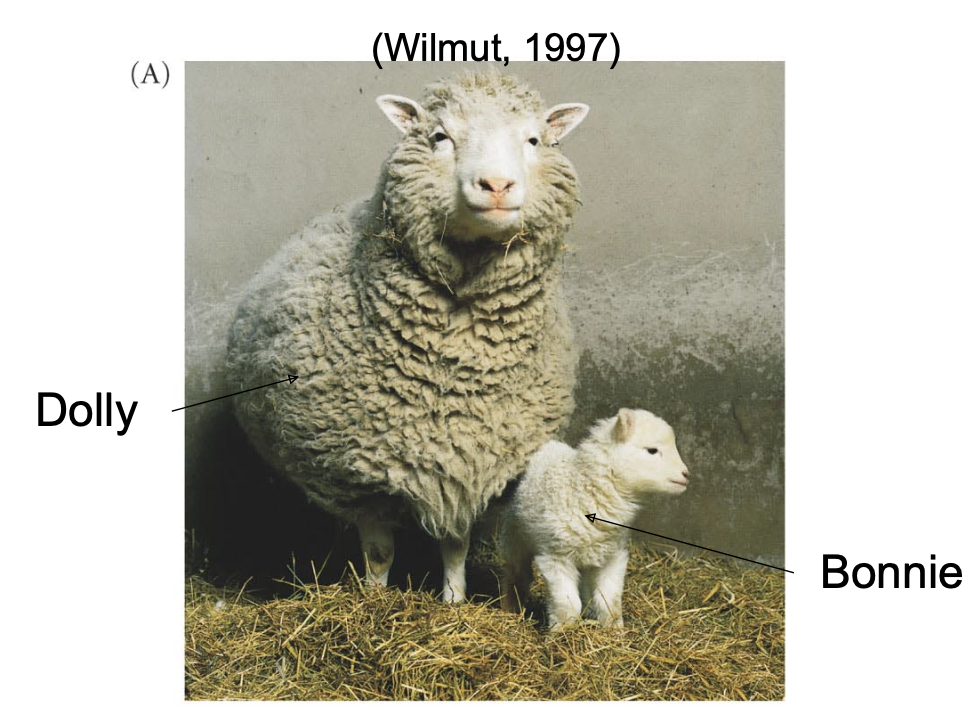
Stem cells can be used in regenerative medicine
what are some of the limitations in terms of ES cells?
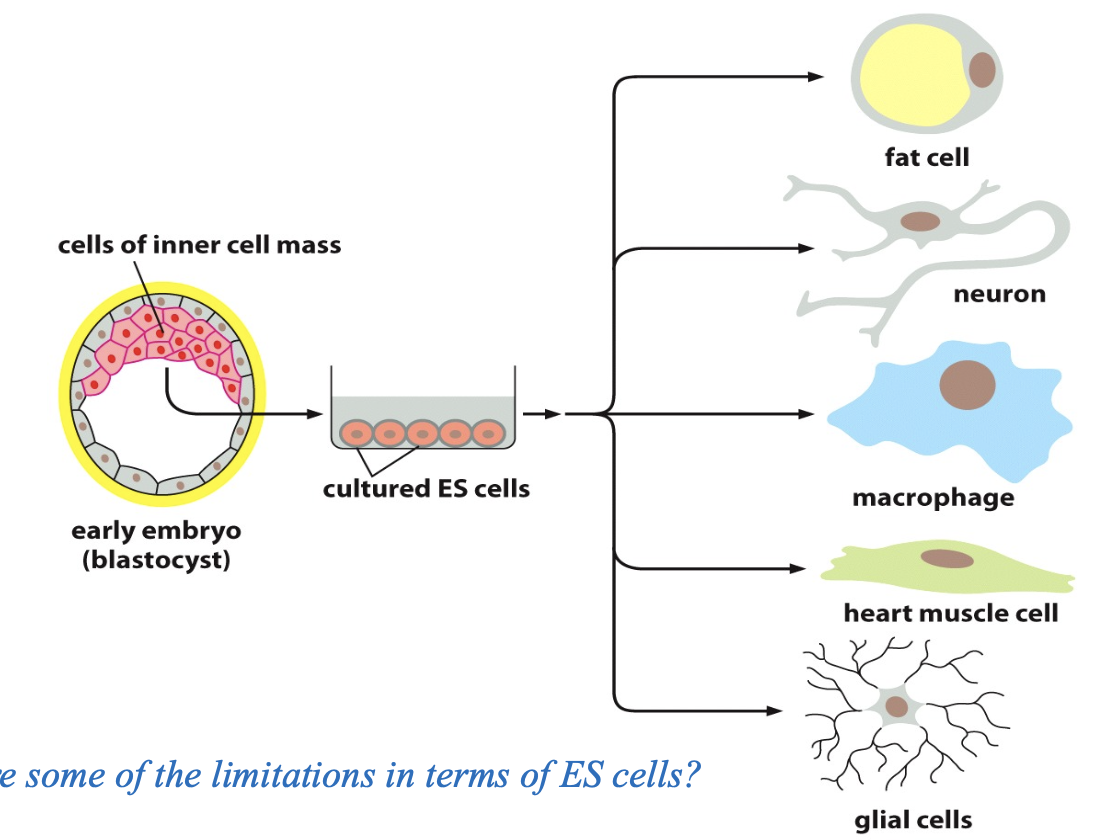
Differentiated cells can be reprogrammed to form induced pluripotent stem cells: iPSCs
in our last lecture, we will cover the mechanisms underlying pluripotency

Stem cells in treatment of macular degeneration
leading cause of blindness in older adults
macular degeneration affects 11 million people in US
results from loss of retinal pigmented epithelial cells (RPE) from the macula
RPE are important for clearing waste and providing nutrients to rod and cone cells which allow us to see!
current non-stem cell treatments delay but do not improve vision
clinical trials @colombia and @johns hopkins - using autologous iPSC-derived RPE tissue

Who won the Nobel prize for the discovery that mature cells can be reprogrammed to become pluripotent?
Sir John B Gurdon and Shinya Yamanaka

Types of research publications
1) primary research papers
report new findings
2) review articles
provide an overview of a particular topic-can be broad or narrow, highlight challenges and outstanding questions in the field (mini-reviews, news and views, perspective, commentary)
3) Methods paper
describe a new methods in detail so others can use them, may contain new scientific findings, but often do not
The publication process
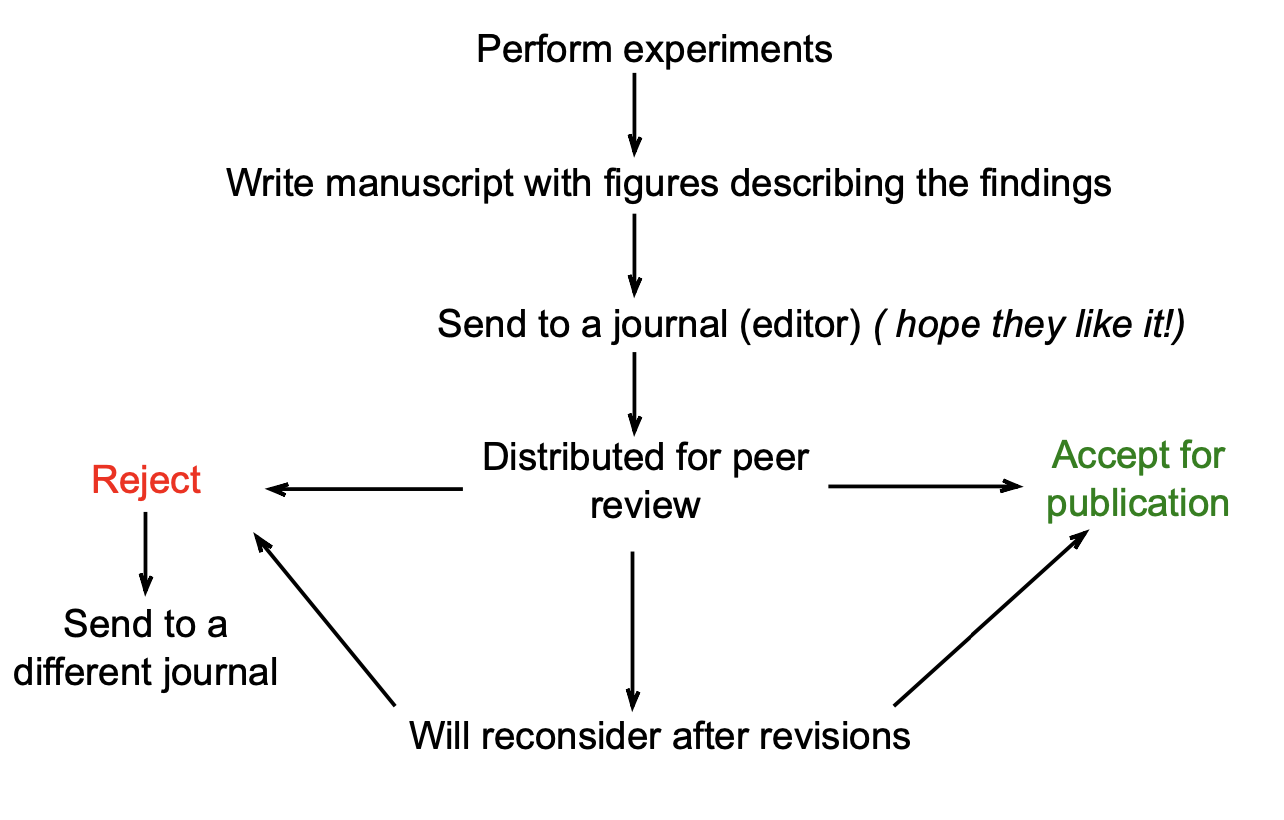
The components of a research paper
abstract: a brief summary of the work
introduction: an overview of the field that tells the reader why the current work is important
methods: details of how the experiments were performed (Note: this section can be the “references and notes” section)
figures: data with figure legends
results: explanation of the date (figures) and interpretation of the results
discussion: describe how the work fits into the larger context of the field
discusses any unusual findings or inconsistencies with what is known
references: citations
supplemental material: additional experiments or explanation of methods
*note: some journals integrate or change order of certain sections
How to approach and summarize a primary research paper
The following questions answered in a couple of succinct sentences will help the process of learning and critiquing new developments in science:
1) what are the major questions asked and hypotheses tested in this manuscript?
2) what are the major tools and methodologies used to test these hypotheses?
3) what are the 2 or 3 most important findings in the paper?
4) what is your personal analysis of the paper?
5) what are 2 strengths and 2 weaknesses of the paper?